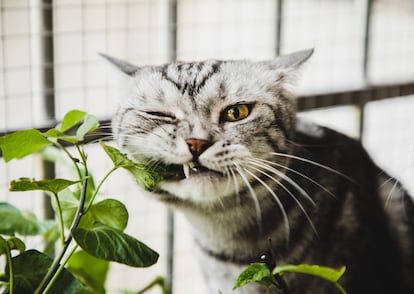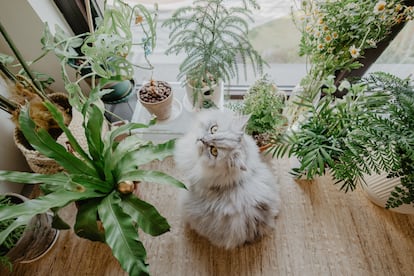Have a pet? Don’t bring home these toxic plants
Many popular house plants can cause diarrhea, rashes, lethal poisoning or other long-term health problems for cats and dogs

A gesture as seemingly harmless as giving flowers or a plant to someone who lives with dogs or cats can lead to a visit to the vet if you are not aware that many varieties can be toxic for pets. The same is true of the botanical trends that promote certain popular plants on social media without considering their toxicity.
The urban jungle trend has filled people’s homes with species as lush as the monstera (Monstera deliciosa / Monstera Adansonii), the flamingo flower (Anthurium spp.), the dumb cane (Dieffenbachia spp.), the peace lily (Spathiphyllum), the elephant ear (Alocasia spp.) and the calla lily (Zantedeschia aethiopica). All these jewels of green interior design, from the Araceae family, so easy to care for and perfect for decorating a corner of the living room, are a danger to small animals due to their high calcium oxalate content. And they are not the only ones.
One of the few ways that the plant world has to defend itself against insects, parasites and fungi, are the chemical substances in their composition (secondary metabolites such as alkaloids, terpenes, glycosides and saponins), which may be present in the leaves, stems, seeds, fruits or bulbs of live plants or cut flowers. If these species are ingested by pets they may not cause death instantly, but they could lead to health problems in the medium and long term due to their possible neuro, hepato, nephro and cardiotoxic agents.
“Many plants that we have in our environment, both in gardens — such as oleanders — and indoors — such as rhododendrons or azaleas — are potentially dangerous for pets. And there are more than we imagine. The Swiss cheese plant, croton, or the typical Christmas plants, holly or mistletoe, for example, are bought without being aware of their toxicity,” explains Marcos Pérez, professor at the faculty of veterinary medicine at the University of Extremadura and member of the Toxicology Research Group of that institution. “Cats and dogs are usually smart and don’t come close, but puppies, more inexperienced and curious, can nibble on them, and that’s where the problems begin. There are also cases of dogs or cats that, according to their owners, never approached or bit a certain plant... until they did. The only way to avoid poisoning is not to introduce these plants into homes with pets,” he adds.
The animals most at risk are the ones that spend several hours alone (and bored) near tempting pots and vases with fresh flowers. With the plants that affect the digestive tract, the poisoning process is quick and the first symptoms are evident: the pets begin to salivate and drool with their tongues sticking out, and gastrointestinal discomfort soon appears. They may also seem lethargic and still. On the other hand, if they ingest plants that affect the urinary tract with a gradual exposure, the owners will notice in the medium and long term that they have trouble or pain when urinating.

However, dogs and cats react differently: cats take longer to complain, until it might be too late. “If you return from work and find the croton lying on the ground and its leaves torn, the recommendation would be to go to the vet immediately, without stopping to think about it, with the pet and the remains of the croton. The same goes for any potentially poisonous plant that we have at home that has been ingested,” explains Pérez.
An epidemiological study on animal poisoning due to plants and zootoxins carried out by the University of Milan (Italy) in collaboration with the Poison Control Center of Milan and published in 2021, highlighted the frequency of poisoning by species containing oxalates, glycosides, alkaloids and diterpenoids, present in the sago palm (Cycas revoluta), poinsettia (Euphorbia pulcherrima) and hydrangea (Hydrangea macrophylla). Another study from the University of Veterinary Sciences Brno (Czech Republic) identified more than 50 poisonous botanical families.
The least of the problems in plants of the Euphorbiaceae family (poinsettia and croton, for example), will be their dermotoxic agent, which in contact with the eyes, can cause itching, irritation, keratoconjunctivitis and corneal erosion, and in contact with the skin will cause swelling, itching and burning. If ingested, after a few hours, inflammation of the mucous membranes of the digestive tract, vomiting and gastrointestinal problems will occur.
Lucky bamboo (Dracaena sanderiana), snake plant (Sansevieria trifasciata), striped dracaena (Dracaena fragrans) and song of Jamaica (Dracaena marginata) all have saponins, which are irritating and potentially hemolytic. The families Amaryllidaceae or Liliaceae, which frequently produce beautiful flowers once a year (tulips, daffodils, hyacinths and crocuses), contain alkaloids, usually concentrated in the bulb, with neurotoxic and cytotoxic effects.
In plants with a high content of calcium oxalates, the first reaction will occur at the dermatological level, with itching and burning of the skin, which in turn causes an inflammatory response and can worsen with blisters, salivation, vomiting, difficulty swallowing and even swelling of the tongue and suffocation. A gradual and sustained consumption of oxalic acid by dogs or cats over time can also cause hypocalcemia, damage to the kidneys and the urinary tract. In the case of lilies, the Czech study points out that all parts of the plant are toxic, including the pollen, and two leaves or petals are enough to kill a cat. Aloe vera, especially the gel inside its leaves, contains saponins and anthraquinones, which will cause vomiting, lethargy and diarrhea, and pothos (Epipremnum aureum), which is common due to its easy care, can cause burning and irritation in the mouth, drooling, vomiting and difficulty swallowing.

How to identify toxic plants?
The consensus is that cats can be more sensitive to the toxicity of ornamental plants, and dogs to outdoor plants. Families with pets can consult updated databases and reports on botanical toxicity, like the toxic and non-toxic plants list offered by the Animal Poison Control Center of the American Society for the Prevention of Cruelty to Animals (ASPCA).
In most cases there are no antidotes, and the only course of action is trying to cleanse the animal’s body as soon as possible, limit the damage and maintain its hydration. In the event of accidental poisoning, the internet is full of recommendations that advise (without any scientific basis) to induce vomit or give them milk, salt or activated charcoal. However, in certain cases, the remedy may turn out to be worse than the disease. A study on the most frequent types of poisoning in small animals published in 2004 warns that activated charcoal is actually contraindicated when it has already started vomiting — which will prevent its absorption — or if there is suspicion of gastrointestinal perforation or pneumonia. It is also ineffective two hours after the ingestion of the poison, except in the case of prolonged elimination agents.
The vet will be able to assess whether it is advisable to induce vomiting or perform a gastric lavage, which will only be effective in the first hour after ingesting the toxic leaves, because after two hours they will already be on their way to the intestine. In this case, treatment with laxatives and adsorbents will be administered to eliminate the toxic agent from the body as soon as possible, while maintaining electrolyte balance with rehydration and fluid therapy.
However, the best option to avoid all this trouble and prevent the suffering of dogs and cats is to nip the danger in the bud by choosing only plants that are safe for all family members.
Sign up for our weekly newsletter to get more English-language news coverage from EL PAÍS USA Edition
Tu suscripción se está usando en otro dispositivo
¿Quieres añadir otro usuario a tu suscripción?
Si continúas leyendo en este dispositivo, no se podrá leer en el otro.
FlechaTu suscripción se está usando en otro dispositivo y solo puedes acceder a EL PAÍS desde un dispositivo a la vez.
Si quieres compartir tu cuenta, cambia tu suscripción a la modalidad Premium, así podrás añadir otro usuario. Cada uno accederá con su propia cuenta de email, lo que os permitirá personalizar vuestra experiencia en EL PAÍS.
¿Tienes una suscripción de empresa? Accede aquí para contratar más cuentas.
En el caso de no saber quién está usando tu cuenta, te recomendamos cambiar tu contraseña aquí.
Si decides continuar compartiendo tu cuenta, este mensaje se mostrará en tu dispositivo y en el de la otra persona que está usando tu cuenta de forma indefinida, afectando a tu experiencia de lectura. Puedes consultar aquí los términos y condiciones de la suscripción digital.
More information
Últimas noticias
Maduro pleads not guilty before the federal court in New York: ‘I am still the president of Venezuela’
A new test can detect Alzheimer’s from a finger prick
UN team enters Sudanese city of El Fasher after paramilitary massacre: ‘It’s like a ghost town’
A recipe for resistance: Indigenous peoples politicize their struggles from the kitchen
Most viewed
- Gilles Lipovetsky: ‘If you want to live better and fall in love, take Prozac, don’t look to philosophy’
- Alain Aspect, Nobel laureate in physics: ‘Einstein was so smart that he would have had to recognize quantum entanglement’
- Alvin Hellerstein, a 92-year-old judge appointed by Bill Clinton, to preside over Maduro’s trial in New York
- Why oil has been at the center of Venezuela-US conflicts for decades
- Maduro’s downfall puts China’s relationship with Venezuela to the test










































